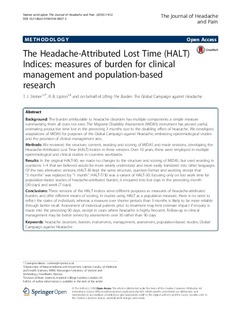| dc.contributor.author | Steiner, Timothy J. | |
| dc.contributor.author | Lipton, Richard B. | |
| dc.date.accessioned | 2019-05-03T06:39:55Z | |
| dc.date.available | 2019-05-03T06:39:55Z | |
| dc.date.created | 2019-01-22T15:18:44Z | |
| dc.date.issued | 2018 | |
| dc.identifier.citation | The Journal of Headache and Pain. 2018, 19 1-5. | nb_NO |
| dc.identifier.issn | 1129-2369 | |
| dc.identifier.uri | http://hdl.handle.net/11250/2596383 | |
| dc.description.abstract | Background
The burden attributable to headache disorders has multiple components: a simple measure summarising them all does not exist. The Migraine Disability Assessment (MIDAS) instrument has proved useful, estimating productive time lost in the preceding 3 months due to the disabling effect of headache. We developed adaptations of MIDAS for purposes of the Global Campaign against Headache, embracing epidemiological studies and the provision of clinical management aids.
Methods
We reviewed the structure, content, wording and scoring of MIDAS and made revisions, developing the Headache-Attributed Lost Time (HALT) Indices in three versions. Over 10 years, these were employed in multiple epidemiological and clinical studies in countries worldwide.
Results
In the original HALT-90, we made no changes to the structure and scoring of MIDAS, but used wording in questions 1–4 that we believed would be more widely understood and more easily translated into other languages. Of the two alternative versions, HALT-30 kept the same structure, question format and wording except that “3 months” was replaced by “1 month”. HALT-7/30 was a variant of HALT-30: focusing only on lost work time for population-based studies of headache-attributed burden, it enquired into lost days in the preceding month (30 days) and week (7 days).
Conclusions
Three versions of the HALT Indices serve different purposes as measures of headache-attributed burden, and offer different means of scoring. In studies using HALT as a population measure, there is no need to reflect the states of individuals, whereas a measure over shorter periods than 3 months is likely to be more reliable through better recall. Assessment of individual patients prior to treatment may best estimate impact if enquiry is made into the preceding 90 days, except in cases where headache is highly frequent. Follow-up in clinical management may be better served by assessments over 30 rather than 90 days. | nb_NO |
| dc.language.iso | eng | nb_NO |
| dc.publisher | BioMed Central | nb_NO |
| dc.rights | Navngivelse 4.0 Internasjonal | * |
| dc.rights.uri | http://creativecommons.org/licenses/by/4.0/deed.no | * |
| dc.title | The Headache-Attributed Lost Time (HALT) Indices: measures of burden for clinical management and population-based research | nb_NO |
| dc.type | Journal article | nb_NO |
| dc.type | Peer reviewed | nb_NO |
| dc.description.version | publishedVersion | nb_NO |
| dc.source.pagenumber | 1-5 | nb_NO |
| dc.source.volume | 19 | nb_NO |
| dc.source.journal | The Journal of Headache and Pain | nb_NO |
| dc.identifier.doi | 10.1186/s10194-018-0837-3 | |
| dc.identifier.cristin | 1663157 | |
| dc.description.localcode | © The Author(s). 2018. Open Access. This article is distributed under the terms of the Creative Commons Attribution 4.0 International License (http://creativecommons.org/licenses/by/4.0, which permits unrestricted use, distribution, and reproduction in any medium, provided you give appropriate credit to the original author(s) and the source, provide a link to the Creative Commons license, and indicate if changes were made. | nb_NO |
| cristin.unitcode | 194,65,30,0 | |
| cristin.unitname | Institutt for nevromedisin og bevegelsesvitenskap | |
| cristin.ispublished | true | |
| cristin.fulltext | original | |
| cristin.qualitycode | 1 | |

